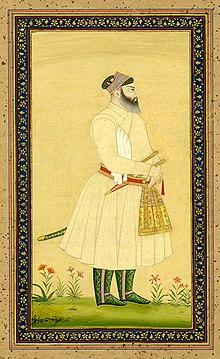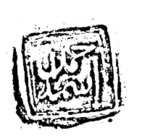Loading AI tools
17th century Mughal chief architect (1580-1649) From Wikipedia, the free encyclopedia
Ustad Ahmad Lahori (c.1580–1649)[1] also known as Ahmad Ma'mar Lahori was the chief Mughal architect and engineer during the reign of emperor Shah Jahan. He was responsible for the construction of several Mughal monuments, including the Taj Mahal in Agra and the Red fort in Delhi; both of which are World Heritage sites.[2] He also designed the Jama Mosque in Delhi.[3]
Ahmad Lahori | |
|---|---|
 Miniature painting of Ustad Ahmad Mimar Lahori | |
| Born | c.1580 |
| Died | c.1649 (aged 68–69) |
| Occupation | Architect |
| Buildings | Taj Mahal Red Fort Old Delhi Jama Masjid, Delhi |
| Signature | |
 | |
Considered greatest of the Mughal architects,[1] Ahmad Lahori came from an illustrious family of architects and civil engineers. He was a skilled engineer who, owing to his architectural abilities, received the title of Nadir-ul-Asar (wonder of the age) from Shah Jahan.[4] His architecture is a combination of Indo-Islamic and Persian architectural styles, and thus a major example of Indo-Persian culture. The architecture of Taj Mahal is widely praised around the world, enabling it to be listed among the Wonders of the World.[5]
Ustad Ahmad Lahori hailed from Lahore, Punjab, as his nisba indicates.[6] He has been described as a Punjabi Muslim[7][8] or an Indian of Iranian heritage.[9] Even after his family's migration to Delhi, his family is still referred to by the epithet "Lahori".[10] In Muslim India, Lahori was used as a synonym for Punjabi by historic writers, such as Amir Khusro who uses it to refer to the spoken language of the people of Punjab, and the Mughal Emperor Jahangir who writes, "In fact they are pure Lahauris and speak the same language."[11][12]
Shah Jahan's court histories emphasize his personal involvement in the construction and it is true that, more than any other Mughal emperor, he showed the greatest interest in building new magnificent buildings, holding daily meetings with his architects and supervisors. The court chronicler, Abdul Hamid Lahori, writes that Shah Jahan would make "appropriate alterations to whatever the skillful architects had designed after considerable thought and would ask the architects competent questions."[13]

In writings by Lahori's son, Lutfullah Muhandis, two architects are mentioned by name; Ustad Ahmad Lahori[14][15] and Mir Abd-ul Karim.[16] Ustad Ahmad Lahori had laid the foundations of the Red Fort at Delhi (built between 1638 and 1648). Mir Abd-ul Karim had been the favourite architect of the previous emperor Jahangir and is mentioned as a supervisor, together with Makramat Khan,[16] for the construction of the Taj Mahal.[17][18]
Lahori had three sons: Ataullah (or Ata Allah Rashidi), Lutfullah (or Lutf Allah Muhandis) and Nurullah (or Nur Allah), who were also involved in architecture besides other fields such as mathematics. Shah Kalim Allah Jahanabadi was his grandson. [19][20]
Ahmad Lahori was learned in the arts of geometry, arithmetic and astronomy. According to his son Lutf Allah Muhandis, he was familiar with the Euclid's Elements and Ptolemy's Almagest.[4] In 1631, Shah Jahan appointed him on the project of construction of Taj Mahal. The construction project employed some 20,000 artisans under the guidance of a board of architects led by Ahmad Lahori. The complex took 12 years for completion.[3] Afterwards, he was relocated to Delhi where emperor ordered him for construction of the new imperial city, Shahjahanabad in 1639.[3] The building of the city, including the Red fort, was complete by 1648. In 1648, Ahmad Lahori started working on the project of the imperial mosque in Delhi, now known as Jama Masjid, Delhi. He died in 1649, before the foundations of mosque were laid.[3] The mosque was later completed by the architect Ustad Khalil.

Seamless Wikipedia browsing. On steroids.
Every time you click a link to Wikipedia, Wiktionary or Wikiquote in your browser's search results, it will show the modern Wikiwand interface.
Wikiwand extension is a five stars, simple, with minimum permission required to keep your browsing private, safe and transparent.